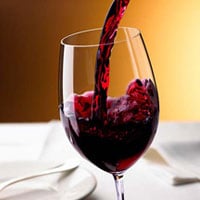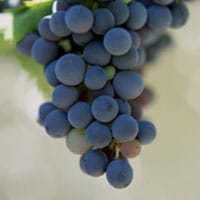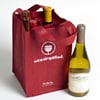Kah-bare-NAY SOH-vin-yawn
It's hard to talk about Cabernet Sauvignon without bringing up the subject of tannins—those astringent compounds that come from oak barrels and the seeds, skins, and stems of grapes. That's because tannins are a prominent part of this wine.
Flavors and Aromas

Cabernet used to be considered a wine you had to cellar for years to allow those tannins to mellow. Today, however, modern winemakers have been able to rein in the grape's rough tannins, highlighting its cassis and black-cherry fruit in a style that is attractive even when young. Higher-end examples ($15 and up) are also apt to feature notes of cassis, mint, and/or bell pepper, as well as a firmer texture (from the thick, tannin-rich skins) and vanilla aromas from aging in oak barrels before bottling. Typically fuller-bodied than other red vareitals at any given price point, Cabernets appeal to sippers who like a bolder wine.
Color
Ranges from dark red to purplish red.
Prominent Plantings
Bordeaux, France, and Napa Valley, California are both hailed for their world-renown Cabs, though good Cabs are emerging from many vineyards worldwide.
Pairing with Food

Look for less expensive examples under $12 to be fairly smooth, but with the flavor concentration to stand up to heartier foods. Grilled or broiled steak is a classic Cab companion; the wine's chewy texture is balanced by the meat's marbled fat. Full-flavored cheeses, sausages, and stews also dovetail nicely with hearty Cabs. Lighter examples are fine with anything from burgers to burritos.
Insider Tip
Style-wise, Cabernets can swing from simply fruity quaffs to rich, tannic, complex collectibles. If you find a style you like and want to explore, start with other labels from the same region before moving up in price or around the map.

 You are about to leave publix.com and enter the Instacart site that they operate and control. Publix’s delivery and curbside pickup item prices are higher than item prices in physical store locations. Prices are based on data collected in store and are subject to delays and errors. Fees, tips & taxes may apply. Subject to terms & availability. Publix Liquors orders cannot be combined with grocery delivery. Drink Responsibly. Be 21. For prescription delivery, log in to your pharmacy account by using the Publix Pharmacy app or visiting
You are about to leave publix.com and enter the Instacart site that they operate and control. Publix’s delivery and curbside pickup item prices are higher than item prices in physical store locations. Prices are based on data collected in store and are subject to delays and errors. Fees, tips & taxes may apply. Subject to terms & availability. Publix Liquors orders cannot be combined with grocery delivery. Drink Responsibly. Be 21. For prescription delivery, log in to your pharmacy account by using the Publix Pharmacy app or visiting 
